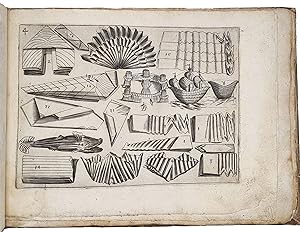giegher mattia (2 Ergebnisse)
Produktart
- Alle Produktarten
- Bücher (2)
- Magazine & Zeitschriften
- Comics
- Noten
- Kunst, Grafik & Poster
- Fotografien
- Karten
-
Manuskripte &
Papierantiquitäten
Zustand
- Alle
- Neu
- Antiquarisch/Gebraucht
Einband
- alle Einbände
- Hardcover
- Softcover
Weitere Eigenschaften
- Erstausgabe
- Signiert
- Schutzumschlag
- Angebotsfoto
Land des Verkäufers
Verkäuferbewertung
-
Il Trinciante [bound with] Lo Scalco.
Erscheinungsdatum: 1621
Anbieter: Henry Sotheran Ltd, London, Vereinigtes Königreich
Padua: Martini Stampator Camerale/ Guasparri Crivellari. 1621/1623. Small oblong quarto. Twentieth century wood-patterned boards; pp. 18, 28 plates illustrating methods of carving meat with manuscript additions, missing folding plate of carving utensils; pp. 47, missing all 3 plates; very good. First editions. Significant because it contains the first printings of two parts of what became Giegher's Tre Trattati (1629). The third part, on napkin folding, was never printed individually. Il Trinciato deals with the art of carving meat, while Lo Scalco (The Steward) concerns service; the three parts together became one of the most important guides to the serving of meals in the best houses, and the carving illustrations are both fascinating and appealing. Mattia Giegher (c.1589 - c. 1639, born Matthias Jager in Moosburg, Bavaria) moved to Italy in around 1616 and was so famed for his mastery of the arts of hospitality that he lectured on the subject at the University of Padua. Banqueting was an important facet of European diplomacy and it was of more than domestic importance that the niceties were performed correctly. Tre Trattati itself is a very rare work, only 17 copies being recorded on Worldcat; it records 2 copies of Lo Scalco, and none of Il Trinciato. Although sadly lacking some plates, this is an item of utmost scarcity.
-
Li tre trattati
Verlag: Paolo Frambotto, 1639
Anbieter: Sokol Books Ltd. ABA ILAB, London, Vereinigtes Königreich
Buch
Hardcover. Zustand: Good. 2nd Edition. Oblong 4to, three parts in one, pp. (xx) including portrait of author, 54 (xxxiv), + 48 engraved plates (two folding), two ll. misplaced. Roman and italic letter, woodcut floriated initials, typographical ornaments, full page engraved portrait of author, 46 full-page engraved plates depicting napkins folded in artistic ways, different types of meat, poultry and fish, fruits and set tables, two fold-out plates illustrating carving knives and forks. Intermittent age yellowing, marginal fingersoiling to some outer margins, deckle edges. A very good, wide-margined copy, crisp and clean, in contemporary carta rustica, covers a little worn. Bookseller s label Chiesa Milano , bibliographic annotations and early manuscript initials G.P. (?) to front paste-down. Second edition of this very rare and beautifully illustrated collection of three culinary treatises on table service and food carving by Giegher, including the very first work on the art of folding table linen. Complete copies, remarkably including Giegher s portrait (often missing) are extremely rare. Li tre trattati was a popular book: this second (posthumous) edition contains a new letter to the reader by the printer Frambotto, warning of a plagiarised version. Giegher s plates have been reproduced and copied in many later cookbooks. The Bavarian Mattia Giegher (born Mathias Jäger, c. 1589-1632) was a native of Moosburg who moved to Padua at the age of 22. Here, he worked as a trinciante (meat carver) and scalco (banquet manager), organising banquets and waiting tables for the prestigious German community of jurists at the University of Padua. At the time, aristocratic banquets were of enormous cultural importance, organised by courts and as a way of displaying wealth and power, consolidating friendships and forming political alliances. Li tre trattati , first published in 1629, is a fascinating manual by Giegher containing all the information required for preparing and serving food to high-class clients. It comprises the expanded versions of two earlier treatises Lo scalco (1623) and Il trinciante (1621) with the addition of a new and innovative work on napkin folding (never printed separately). At the time, fine dining was becoming more formal and elaborate in presentation: this work is an extraordinary witness of the unusual and extravagant dining practices of the rich and famous. In his Trattato delle piegature (Treatise on folding), Gieger for the first time describes in detail the art of napkin folding, using images for teaching and creative purposes. In addition to explaining how to fold napkins for wiping hands and mouth, he shows how to create complex artistic sculptures, called folded centrepieces. Renaissance table linens were expected to surprise and entertain: the plates in this treatise depict centrepieces shaped as birds, lions, fish, a crab, a tortoise, a dog, heraldic and mythological creatures, even a ship with four sails. These sculptures were not merely decorative, but objects with a symbolic meaning to be discussed by the participants. Interestingly, rather than providing models of certain shapes to be reproduced, Giegher teaches how to master the basic folding techniques (fan, curved and herringbone) so that the aspirant folder could invent his own designs. The second treatise is dedicated to the profession of the scalco , sometimes translated as head steward or banquet manager . The scalco was responsible for the organisation of every aspect of the banquet and for its success, from hiring the chefs and selecting what dishes to serve, to setting the tables. In this treatise, Giegher summarises the knowledge and skills that a scalco needs to possess: the first part explores the seasonality of foods indicating the best months of the year for eating certain meats, vegetables, fruits and mushrooms. Then, the author proposes long menus for meals that are perfect for different seasons or occasions: for example, the menu of a br.


![Bild des Verkäufers für Il Trinciante [bound with] Lo Scalco. zum Verkauf von Henry Sotheran Ltd](https://pictures.abebooks.com/inventory/md/md22479560361.jpg)
